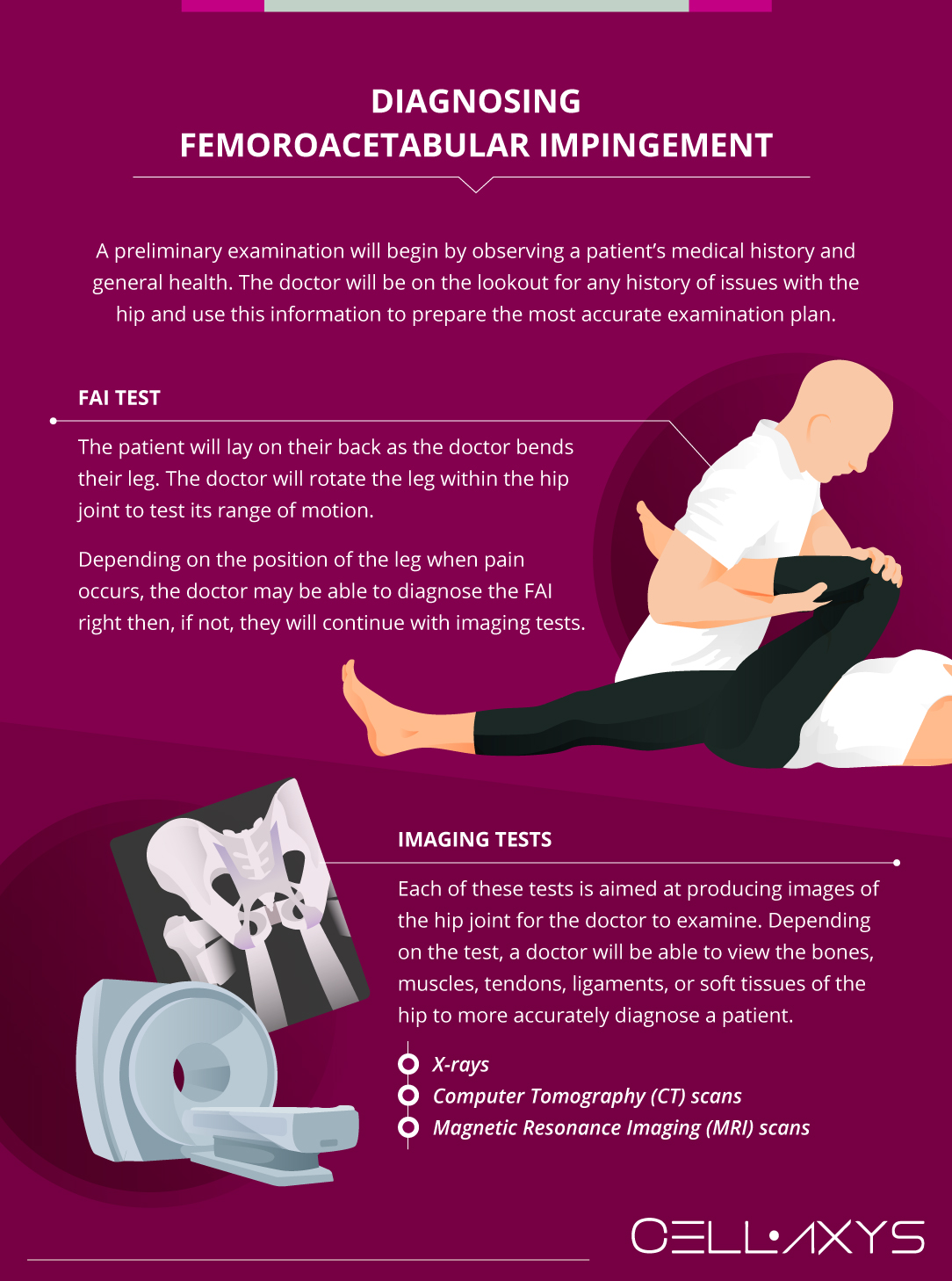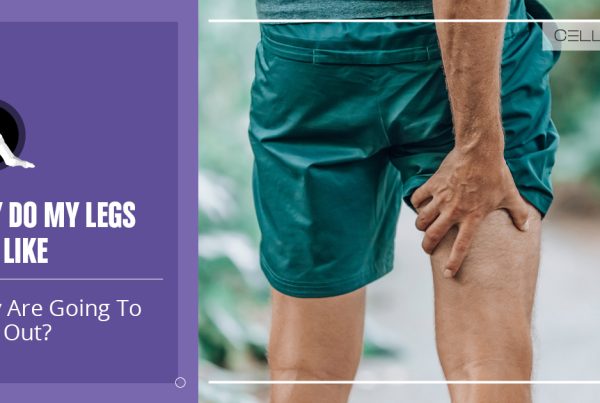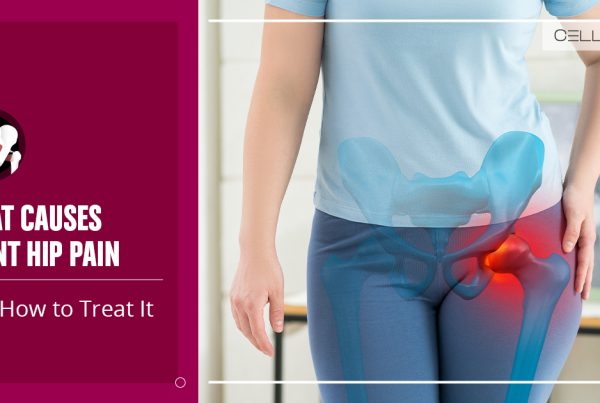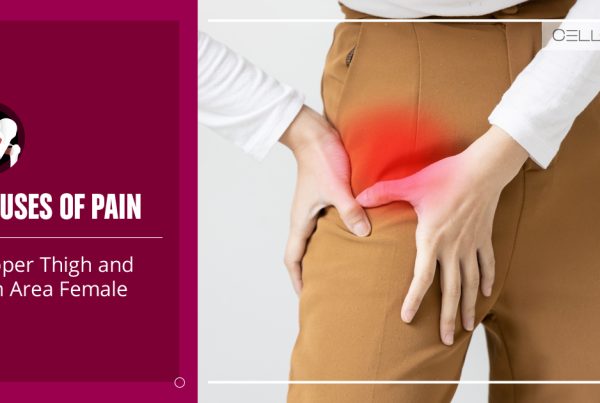Published on: October 4, 2019 | Updated on: August 29, 2024
Femoroacetabular impingement is when tissues in the hip joint are pinched and begin to express pain. As the condition progresses, the pain may escalate, leaving an individual permanently debilitated.
Though there are many treatment options to consider, it may be helpful to learn more about which portions of the hip are involved, how the condition manifests itself, and the options available to those who suffer from it.
Anatomy of Femoroacetabular Impingement
The hip is what’s known as a “ball and socket” joint where the “ball” is made up of the rounded head of the femur (upper portion of the thigh bone), and the “socket” is made up of the cavity formed by the pelvic bone (known as the acetabulum).
The head of the femur is held by a sleeve of very powerful ligaments connecting to the pelvis. These ligaments provide stability and help ensure the femur stays within a certain range of motion.
The femoral head and the pelvic cavity are covered by a smooth layer of cartilage which helps cushion the joint’s movements. This cartilage ensures that the bones slide smoothly against one another with minimal friction.
In addition to the cartilage and ligaments, a layer of rubber-like fibrocartilaginous tissue forms a rim around the “socket” in the pelvis, increasing its depth and, in turn, the stability of the femoral head within the pelvic cavity. This rim is called the labrum, and it acts as an o-ring or gasket to help secure the femoral head within the pelvic cavity.
Suppose even one of these components does not function properly. In that case, this limits the range of motion of the femoral head within the pelvis cavity and leads to femoroacetabular impingement (FAI).
Femoroacetabular impingement is simply the name given to the act of the two hip joint bones colliding with one another and pinching the labrum. As the head or neck of the femur collides with the socket in the pelvis, the labrum is compressed, and an individual begins to feel pain.
Signs and Symptoms of Femoroacetabular Impingement
An individual may have FAI for quite some time before the symptoms begin to manifest as pain which typically doesn’t occur until the latter stages of the condition.
As FAI develops, an individual may begin to experience:
- Aches and pain in the inner hip or groin area
- Locking or “catching” of the hip joint
- Pops, clicks, and other noises and sensations
- Pain after sitting for long periods
- Difficulty walking uphill
- Reduced range of motion for the leg
- Weakness at the outer limits of leg movement
- Hip instability
These symptoms typically manifest over time. Strenuous activity may make them more apparent at first, but over a few years, the symptoms will manifest with more subtle activities. As the condition progresses, it may cause various other issues, such as osteoarthritis.
Causes of Femoroacetabular Impingement
When doctors examine a patient for FAI, they will look for two probable causes – a deformity of the ball or a deformity of the hip socket.
Femoral Head (Ball) Deformity
A deformity of the hip joint ball causes a condition known as “cam impingement.” If the shape of the head of the femur is irregular, this abnormality can cause a jam as a person bends at the hip. The abnormality will snag on the cavity in the pelvis and cause a reduction in the range of motion of the hip.
Acetabulum (Socket) Deformity
A deformity of the socket of the hip joint causes a condition known as “pincer impingement”. If the rim of the acetabulum (cavity of the pelvis) extends out too far, the neck of the femur (the portion just below the femoral head) may collide with the rim of the hip socket and pinch the labrum.
Both of these abnormalities cause the labrum to become pinched and will eventually lead to a diagnosis of FAI. Additionally, these deformities are not unique to each other and may occur simultaneously, causing much worse problems and more rapid development of FAI.
Diagnosing Femoroacetabular Impingement

A preliminary examination will begin by observing a patient’s medical history and general health. The doctor will be on the lookout for any history of issues with the hip and use this information to prepare the most accurate examination plan.
Suppose FAI is suspected after examining a patient’s medical records. In that case, the doctor will proceed with a physical examination involving an FAI test or use imaging technology to take a closer look at the structure of the hip joint.
FAI Test
If FAI is suspected, the doctor will add an impingement test to a patient’s physical examination. The patient will lay on their back as the doctor bends their leg. The doctor will rotate the leg within the hip joint to test its range of motion.
Depending on the position of the leg when pain occurs, the doctor may be able to diagnose the FAI right then; if not, they will continue with imaging tests.
Imaging Tests
Doctors will use a range of medical imaging technologies to check the structures within the hip joint.
These include:
- X-rays
- Computer Tomography (CT) scans
- Magnetic Resonance Imaging (MRI) scans
Each of these tests aims to produce images of the hip joint for the doctor to examine. Depending on the test, a doctor can view the bones, muscles, tendons, ligaments, or soft tissues of the hip to more accurately diagnose a patient.
With the tests concluded and the results positive, the doctor will recommend a course of treatments.
Conventional Treatments for Femoroacetabular Impingement
Nonsurgical treatments should be the first consideration for treating FAI. Often, FAI’s pain can be resolved with a few hours of rest, over-the-counter anti-inflammatory medication, and physical therapy. These conservative approaches can help manage a person’s FAI enough to help them continue their life at a comfortable, functional level.
Medication
Medication such as ibuprofen, naproxen, and acetaminophen will be recommended if FAI pain is minimal. These medications help to reduce inflammation and increase blood flow, thereby reducing the compression around the nerves within the hip.
Suppose these over-the-counter remedies are not effective enough for an individual to reach their functional goals. In that case, doctors may prescribe higher dosages of the same medication or alternatives to block the body’s response to pain.
Steroidal Injections
If medication fails to reduce inflammation to the patient’s satisfaction, doctors may recommend steroidal injections. While these procedures help reduce inflammation, they come at a cost.
Over time, steroid injections have been shown to break tissues down, and prolonged use may lead to complete joint dysfunction. It’s best to approach steroidal injections with caution.
Physical Therapy
Adding a physical therapy routine is a recommended practice for any joint issue. Massage, exercise, stretching, hot/cold treatments, or any treatment which involves a physical element fall into this category of treatments.
The benefit for patients here is that they may recreate these therapies within their own home via self-massage, yoga, hot pads, or other physical aids. If they are not satisfied with the results of self-administered physical therapy, they may reach out to their doctors for a professional consultation.
Arthroscopy
As a last resort, patients may be referred for surgical treatment. Surgery for FAI is typically non-invasive and involves the use of a tool called an arthroscope.
After administering the anesthetic, arthroscopy will begin with a small incision near the hip. The arthroscope uses a small camera and a set of tools at the end of the scope to shave off and extract pieces of the abnormal bones in the hip.
The doctor will recommend that a patient rests for 2 weeks to reduce the weight on the recovering hip. After this, it may take 6 months or more for the patient to experience reduced pain and swelling.
Additionally, a physical therapy and medication routine may also be lumped in with the surgery to increase the chances of success.
While these conventional treatments are the most popular, they come with long recovery periods and may be ineffective. If these treatments do not return enough functionality to the hip joint after FAI has begun to run its course, there are alternatives to consider.
Orthobiologic Therapy for Femoroacetabular Impingement
Regenerative or orthobiologic therapies offer an alternative to conventional treatment options. By using tissues found naturally in the body, regenerative therapies, such as “Cell-based therapies” and “Platelet-Rich Plasma (PRP) therapy,” can help control inflammation, reduce pain, and increase the functionality of the hip joint.
Cell-based and PRP therapies involve harvesting the tissues from a patient’s body and replacing them with healthy cells and tissues. These orthobiologic procedures are typically performed under anesthesia, making them less painful than typical surgical procedures.
Cell-based Therapies
Also known as stem cell therapy, cell-based therapies focus on your analogous tissues, the ones present in your body naturally. These include your adipose (fat), blood, and bone marrow cells. The healthcare provider harvests damaged cells from the injured area and inject healthier ones.
The two main types of cell-based therapies are:
- Minimally Manipulated Adipose Tissue transplant (MMAT): This procedure focuses on harvesting your damaged adipose tissues and replacing them with new ones. One great benefit of MMAT is that your doctor can perform the transplant at multiple locations in the same procedure.
- Bone Marrow Concentrate (BMAC): This cell-based therapy targets your injured bone marrow cells and transplants them with healthy ones.
These cell-based therapies usually take about 1.5-2 hours to complete. They are performed as outpatient procedures, so your doctor may allow you to go home after the process.
PRP Therapy
PRP focuses on isolating platelets from the patient’s plasma and then re-injecting it into the damaged site. Platelets are an essential part of our body’s blood as they contain proteins that stimulate healing and release 10 types of tissue growth factors. They also serve as the first line of defense in your FAI healing process.
Platelets also send chemical impulses in your body to attract healing cells and reduce the inflammation within the hip. The most important function of platelets is the production of fibrin, a sticky web that produces a scaffolding for healthy tissues to develop.
PRP is used in treating several orthopedic and spine injuries. The procedure only takes 45 minutes to complete.
The added benefit of regenerative therapy over conventional treatments is that they not only treat the pain but the source of it as well. If the labrum is degraded, there is only so much that conventional treatments can do. They may be able to help a patient avoid inducing pain, but they will not be able to help stop the progression of FAI. Regenerative therapies do.
Sources
Footnotes
- Zhang C, Li L, Forster BB, Kopec JA, Ratzlaff C, Halai L, Cibere J, Esdaile JM. Femoroacetabular impingement and osteoarthritis of the hip. Canadian Family Physician. 2015;61(12):1055-60.
- Menge TJ, Truex NW. Femoroacetabular impingement: a common cause of hip pain. The Physician and Sportsmedicine. 2018;46(2):139-44.
- Dooley PJ. Femoroacetabular impingement syndrome: Nonarthritic hip pain in young adults. Canadian Family Physician. 2008;54(1):42-7.
- Samora JB, Ng VY, Ellis TJ. Femoroacetabular impingement: a common cause of hip pain in young adults. Clinical Journal of Sport Medicine. 2011;21(1):51-6.
- Harris JD, Erickson BJ, Bush-Joseph CA, Nho SJ. Treatment of femoroacetabular impingement: a systematic review. Current reviews in musculoskeletal medicine. 2013;6:207-18.
- Wall PD, Fernandez M, Griffin DR, Foster NE. Nonoperative treatment for femoroacetabular impingement: a systematic review of the literature. PM&R. 2013;5(5):418-26.
- Pountos I, Panteli M, Walters G, Bush D, Giannoudis PV. Safety of epidural corticosteroid injections. Drugs in R&D. 2016;16:19-34.
References
- Hip Anatomy. ARTHRITIS-Health. Accessed 2/26/2024.
- Femoroacetabular Impingement. OrthoInfo. Accessed 2/26/2024.
- Femoroacetabular Impingement (FAI). Cleveland Clinic. Accessed 2/26/2024.
CELLAXYS does not offer Stem Cell Therapy as a cure for any medical condition. No statements or treatments presented by Cellaxys have been evaluated or approved by the Food and Drug Administration (FDA). This site contains no medical advice. All statements and opinions are provided for educational and informational purposes only.
Dr Pouya Mohajer
Author
Pouya Mohajer, M.D. is the Director of Spine and Interventional Medicine for CELLAXYS: Age, Regenerative, and Interventional Medicine Centers. He has over 20 years of experience in pain management, perioperative medicine, and anesthesiology. Dr. Mohajer founded and is the Medical Director of Southern Nevada Pain Specialists and PRIMMED Clinics. He has dedicated his career to surgical innovation and scientific advancement. More about the doctor on this page.
Dr Pejman Bady
Contributor
Dr. Pejman Bady began his career over 20 years ago in Family/Emergency Medicine, working in fast-paced emergency departments in Nevada and Kansas. He has served the people of Las Vegas as a physician for over two decades. Throughout this time, he has been met with much acclaim and is now the head of Emergency Medical Services in Nye County, Nevada. More about the doctor on this page.









